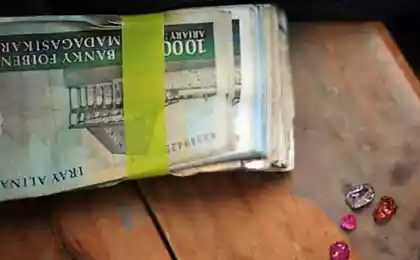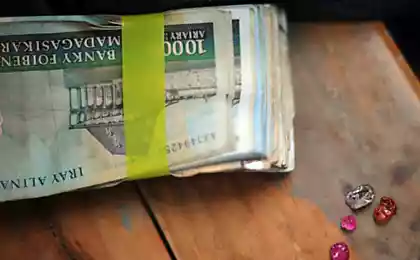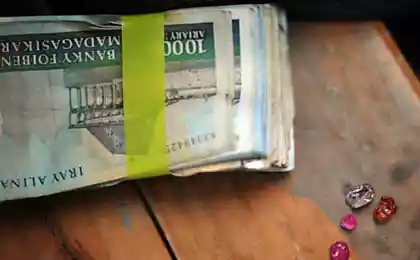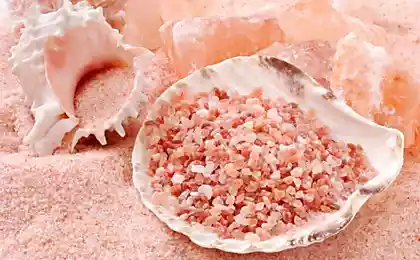4897
Salt Mines Soledar
Soledar salt mines - one of the purest and oldest salt deposits in the world and the largest in salt production in Europe. Today we will go to one of these mines and learn if they are. Brief historical background
In 1880, near the village in the Donbas Bryantsevka was discovered a large underground salt mine. In the next year was put into operation the first mine began commercial production of rock salt. This event marked the beginning of the enterprise actually "Artyomsol" and the development of the current Soledar. Its present name in honor of the company received FA Artem. Now SE "Artyomsol" - the largest enterprise for production and sale of salt in Central and Eastern Europe: the products are delivered to 22 countries.
The company is capable of producing more than 7 million. Tons of salt per year. In Soviet times, "Artyomsol" makes up 40% of the all-union production of rock salt.
Extraction of salt Artiomovskiy deposit occurs at depths of 200-300 m. For more than a hundred years to produce a system workings length of about 300 km, has produced more than 250 million. Tons of salt, the void volume exceeded 110 million cubic meters. m. Despite the large amount of excavation, currently developed only 3% salt, which is available in the field. So Soledar salt reserves will suffice for a long time.
In one of the waste is placed underground workings department speleosanatorium "Salt Symphony", which is the treatment of respiratory diseases. At the same time there may heals up to 100 people. Here are conducted guided tours and there is even an underground museum salt industry. Tourist site takes a couple of kilometers from the force.

On arrival at the destination we were met by one of the many headgears that are scattered Donbas, and the inscription "GP Artemsol" over the entrance.
Tragically, despite the uniqueness and attractiveness of this industrial tourism object, get into it yourself is not as easy as we would like. Although all phones, password and appearance have long been published on the Internet. Firstly, to record on a trip you need to pass a quest. Priority is given to large groups. If you want to go alone, then about availability can be learned only the day before, because you have to join a foreign group. Inconvenient. But when writing a large group at once, there are many problems. Recorded in advance is necessary because Weekend usually all busy for a month or two in advance. This will also need to advance in full prepayment is required. Secondly, the infrastructure around Soledar poorly developed. Public transport, for example, from Donetsk goes relatively rare, and travel takes time. In general, one can see that the tour here - it's a kind of spin-off activities, which is supported in the lowest possible condition, but is not actively developing. On the other hand, due to the fact that the subject is poorly developed for tourism and is not promoted and licked as the same Polish Wieliczka, here you can see salt mines authentic, untouched marketing and tourism business.

From the first steps is felt that there is still a going concern and not a developed tourist attraction :)

But down in the mine just will not work :) First you need to sign for safety.

Now, finally, you can go down.

Descent to the tourist zone occurs through the shaft 3 bis, which now serves as a vent.

Tourist level is at a depth of 288 m. The speed of descent of 3, 75 m / s and only a minute and a half we already find ourselves at the bottom. During the descent ears pop.

Ruddvor and mine cages. Sam trunk almost the entire height of a lining of iron tubing.
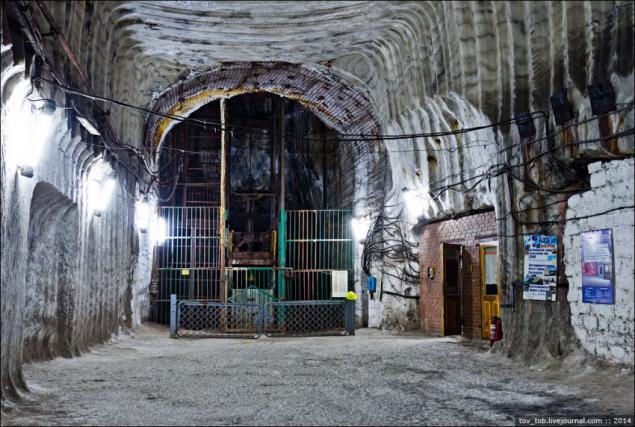

The walls are made of salt. The Code of salt. Paul (suddenly!) Is also made of salt. Such a huge salt shaker, inside which you can walk.

Salt deposits beginning to emerge 250 million. Years ago from the salt deposits of the shallow Gulf of ancient sea, which was on the site of the present Soledar.

Walls and ceilings are covered with mines like waves - so unusual looks salt layer in the cut. Each layer was formed about 100 thousand. Years.

In the tourist area and Speleosanatorium can see a number of sculptures and bas-reliefs of salt, created by local craftsmen. For example, the patron of miners - Good Shubin. The letters AC - logo "Artyomsol».

Power (thickness) of the horizon in this location - 30 m.

The main entrance to the underground part speleosanatorium:

I otkovyryat couple of pieces of salt from the walls and tasted - salt was delicious and clean. In general, however, say that the salt from local deposits can be packaged in bags almost immediately without purification.

Analogue palm Mertsalova also created from the salt:

Our guide tells about salt mining technology:

Entrance to the museum salt industry. Bricks around the door are made of salt crystals and have dynamic lighting is constantly changing color. In the museum we do not go - there is nothing really interesting there. It is better to look at what's inside speleosanatory.

For show entrance to speleosanatory:
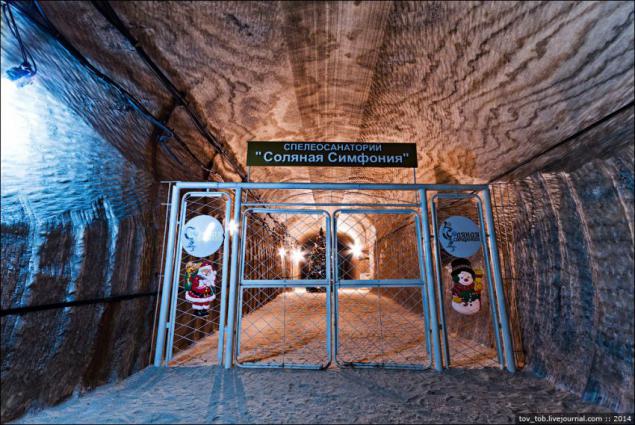
Remains of the New Year:

The temperature in the mines is always in the range of about 15 ° C.
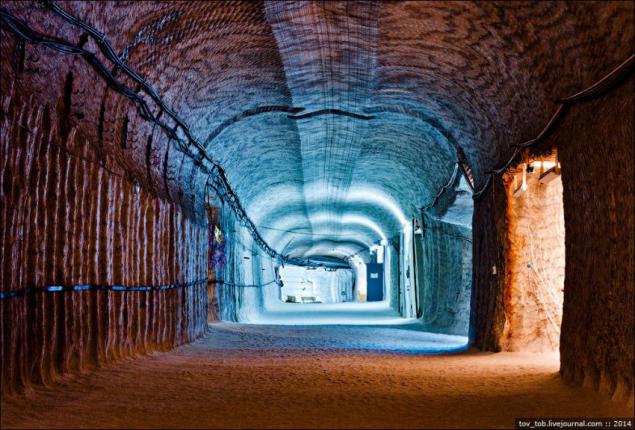
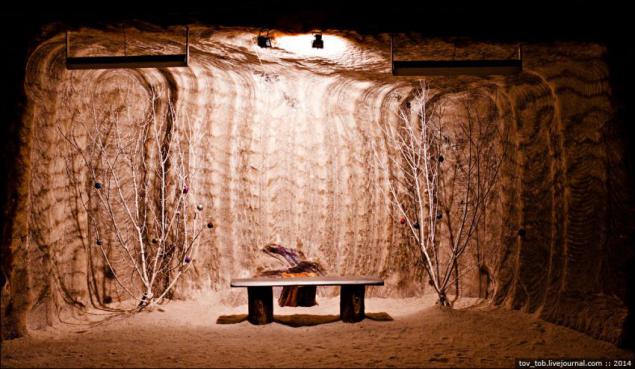
Generation, are in an array of rock salt are completely dry. Water - the main problem of salt deposits. If the dry salt mines do not require additional strengthening and beautifully maintained rock pressure, then in contact with water, they begin to rapidly deteriorate. Therefore waterproofing here pay special significance.
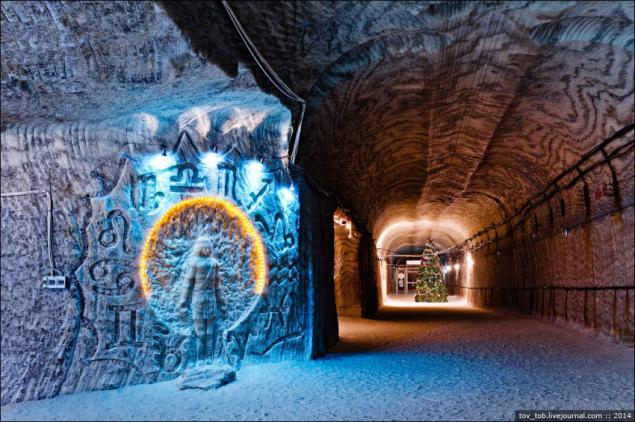
The beauty of Soledar that here until well preserved traces of the actual production of salt: walls and arches carved with characteristic patterns of tunneling machines.

This is the deepest toilet, which I've seen :)

Branch to relax patients. For curtains are beds.

Local improvement:
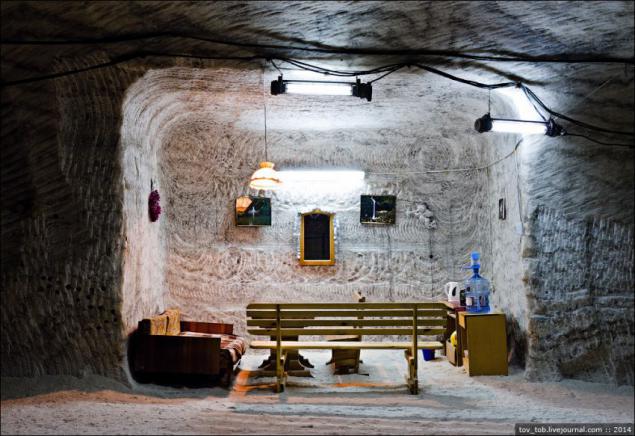
Another long development, which can not only relax but also to have a good time:

Cafe:
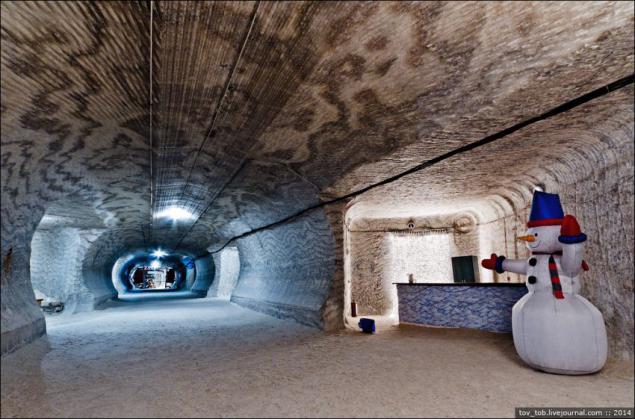
In one of the corners, you can find a table with chess and checkers:


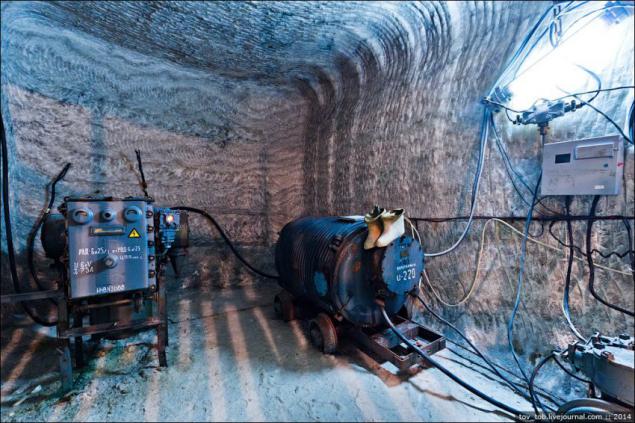
So looking Sleeps:

There is literally everything :)

You can play table tennis:

Fans will be happy with even Alla. Once Diva went down to the local salt mine and since that memorable day were these pictures:

Salt in the context of:

And most epic - a chamber 42 having a height of 27 m and 100 m in length.
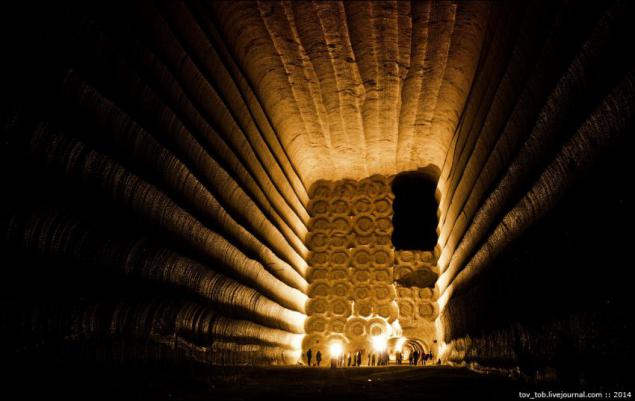
Similar to her size and filling the chamber 41 bis, which abuts the salt museum, better known: it has repeatedly held a concert symphony orchestra, and in 2003 was recorded record listed in the Guinness Book of Records as the first underground ballooning hot air balloon ( !). Well, at the usual time in the chamber 41 bis has a mini-cafe, sometimes hosts exhibitions, conferences and in her drive tourists who do not attend speleosanatory (photo from nice-places.com).

to return to the chamber 42. The walls and in the end noticeable characteristic traces of the tunnel boring machine cutters. The camera was developed by multiple layers of penetration from the top down. By the number of roundels in the end you can easily count the number of passes of the combine (two roundels = 1 pass).

Here, for example, looks harvester Ural-20 COP (photo mishainik). Picture taken not Soledari, but the essence remains the same.
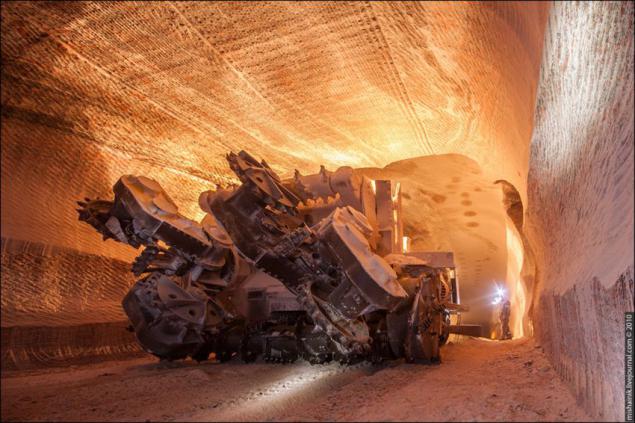
You can play football :)

In general, the visit is definitely worth Soledari.

Source: tov-tob.livejournal.com
In 1880, near the village in the Donbas Bryantsevka was discovered a large underground salt mine. In the next year was put into operation the first mine began commercial production of rock salt. This event marked the beginning of the enterprise actually "Artyomsol" and the development of the current Soledar. Its present name in honor of the company received FA Artem. Now SE "Artyomsol" - the largest enterprise for production and sale of salt in Central and Eastern Europe: the products are delivered to 22 countries.
The company is capable of producing more than 7 million. Tons of salt per year. In Soviet times, "Artyomsol" makes up 40% of the all-union production of rock salt.
Extraction of salt Artiomovskiy deposit occurs at depths of 200-300 m. For more than a hundred years to produce a system workings length of about 300 km, has produced more than 250 million. Tons of salt, the void volume exceeded 110 million cubic meters. m. Despite the large amount of excavation, currently developed only 3% salt, which is available in the field. So Soledar salt reserves will suffice for a long time.
In one of the waste is placed underground workings department speleosanatorium "Salt Symphony", which is the treatment of respiratory diseases. At the same time there may heals up to 100 people. Here are conducted guided tours and there is even an underground museum salt industry. Tourist site takes a couple of kilometers from the force.

On arrival at the destination we were met by one of the many headgears that are scattered Donbas, and the inscription "GP Artemsol" over the entrance.
Tragically, despite the uniqueness and attractiveness of this industrial tourism object, get into it yourself is not as easy as we would like. Although all phones, password and appearance have long been published on the Internet. Firstly, to record on a trip you need to pass a quest. Priority is given to large groups. If you want to go alone, then about availability can be learned only the day before, because you have to join a foreign group. Inconvenient. But when writing a large group at once, there are many problems. Recorded in advance is necessary because Weekend usually all busy for a month or two in advance. This will also need to advance in full prepayment is required. Secondly, the infrastructure around Soledar poorly developed. Public transport, for example, from Donetsk goes relatively rare, and travel takes time. In general, one can see that the tour here - it's a kind of spin-off activities, which is supported in the lowest possible condition, but is not actively developing. On the other hand, due to the fact that the subject is poorly developed for tourism and is not promoted and licked as the same Polish Wieliczka, here you can see salt mines authentic, untouched marketing and tourism business.

From the first steps is felt that there is still a going concern and not a developed tourist attraction :)

But down in the mine just will not work :) First you need to sign for safety.

Now, finally, you can go down.

Descent to the tourist zone occurs through the shaft 3 bis, which now serves as a vent.

Tourist level is at a depth of 288 m. The speed of descent of 3, 75 m / s and only a minute and a half we already find ourselves at the bottom. During the descent ears pop.

Ruddvor and mine cages. Sam trunk almost the entire height of a lining of iron tubing.


The walls are made of salt. The Code of salt. Paul (suddenly!) Is also made of salt. Such a huge salt shaker, inside which you can walk.

Salt deposits beginning to emerge 250 million. Years ago from the salt deposits of the shallow Gulf of ancient sea, which was on the site of the present Soledar.

Walls and ceilings are covered with mines like waves - so unusual looks salt layer in the cut. Each layer was formed about 100 thousand. Years.

In the tourist area and Speleosanatorium can see a number of sculptures and bas-reliefs of salt, created by local craftsmen. For example, the patron of miners - Good Shubin. The letters AC - logo "Artyomsol».

Power (thickness) of the horizon in this location - 30 m.

The main entrance to the underground part speleosanatorium:

I otkovyryat couple of pieces of salt from the walls and tasted - salt was delicious and clean. In general, however, say that the salt from local deposits can be packaged in bags almost immediately without purification.

Analogue palm Mertsalova also created from the salt:

Our guide tells about salt mining technology:

Entrance to the museum salt industry. Bricks around the door are made of salt crystals and have dynamic lighting is constantly changing color. In the museum we do not go - there is nothing really interesting there. It is better to look at what's inside speleosanatory.

For show entrance to speleosanatory:

Remains of the New Year:

The temperature in the mines is always in the range of about 15 ° C.


Generation, are in an array of rock salt are completely dry. Water - the main problem of salt deposits. If the dry salt mines do not require additional strengthening and beautifully maintained rock pressure, then in contact with water, they begin to rapidly deteriorate. Therefore waterproofing here pay special significance.

The beauty of Soledar that here until well preserved traces of the actual production of salt: walls and arches carved with characteristic patterns of tunneling machines.

This is the deepest toilet, which I've seen :)

Branch to relax patients. For curtains are beds.

Local improvement:

Another long development, which can not only relax but also to have a good time:

Cafe:

In one of the corners, you can find a table with chess and checkers:



So looking Sleeps:

There is literally everything :)

You can play table tennis:

Fans will be happy with even Alla. Once Diva went down to the local salt mine and since that memorable day were these pictures:

Salt in the context of:

And most epic - a chamber 42 having a height of 27 m and 100 m in length.

Similar to her size and filling the chamber 41 bis, which abuts the salt museum, better known: it has repeatedly held a concert symphony orchestra, and in 2003 was recorded record listed in the Guinness Book of Records as the first underground ballooning hot air balloon ( !). Well, at the usual time in the chamber 41 bis has a mini-cafe, sometimes hosts exhibitions, conferences and in her drive tourists who do not attend speleosanatory (photo from nice-places.com).

to return to the chamber 42. The walls and in the end noticeable characteristic traces of the tunnel boring machine cutters. The camera was developed by multiple layers of penetration from the top down. By the number of roundels in the end you can easily count the number of passes of the combine (two roundels = 1 pass).

Here, for example, looks harvester Ural-20 COP (photo mishainik). Picture taken not Soledari, but the essence remains the same.

You can play football :)

In general, the visit is definitely worth Soledari.

Source: tov-tob.livejournal.com











